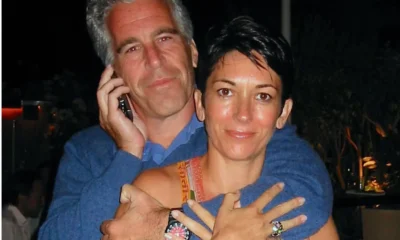Entertainment
Tricia Lucus: Who is Toby Keith’s Wife? on February 6, 2024 at 2:58 pm The Hollywood Gossip
For reasons extremely unfortunate and tragic, Tricia Lucus is in the news at the moment.
This is due to the loss of Toby Keith,, the country music superstar who died on Monday night at the age of 62.
Keith had been diagnosed with stomach cancer in 2021 and, according to a statement from his family, “passed peacefully, surrounded by his family.”
This same message added that the artist “fought his fight with grace and courage.”
Toby Keith and Tricia Lucus attend the 2023 People’s Choice Country Awards in this photo of the spouses. (Photo by Terry Wyatt/Getty Images) (Photo by Terry Wyatt/Getty Images)
Keith produced 61 tracks that appeared on the Billboard Hot Country Songs, with 20 of them hitting number-one and 22 others landing in the top 10.
Throughout his three-decade long career, the musician released 24 studio and compilation albums, along with two Christmas records… generating $40 million in global sales.
In September of last year, Keith took home the Country Music Icon Award at the People’s Choice Country Awards.
Toby Keith performs onstage during the 34th Annual Nashville Symphony Ball at Schermerhorn Symphony Center on December 8, 2018 in Nashville, Tennessee. (Photo by Jason Kempin/Getty Images)
Lucus, meanwhile, met Keith shortly after after she graduated from high school, back when Keith was working in the oil fields and trying to turn his music dreams into a professional reality.
The couple, who met at a bar, dated for three years and got married in 1984.
“I was 19 and he was 20,” Lucus told People Magazine in 2001. “He was just one of those larger-than-life guys, full of confidence.”
Not much changed about Keith over the many decades since.
Toby Keith performs at the 2019 CMT Music Awards at Bridgestone Arena on June 5, 2019 in Nashville, Tennessee. (Photo by Anna Webber/Getty Images for CMT)
Lucus is a mom to three kids.
She gave birth to her first daughter, Shelley Covel Rowland in 1980, prior to meeting Keith.
After they became husband and wife, Keith adopted Shelley… and the spouses went on to have two more children:
Daughter Krystal in 1985 and son Stelen in 1997.
Toby Keith performs onstage for the BMI Icon Award during the 2022 BMI Country Awards at BMI on November 8, 2022 in Nashville, Tennessee. (Photo by Jason Kempin/Getty Images for BMI)
Keith gushed openly about his wife on numerous occasions.
“I absolutely love performing and writing songs, but being at home with my wife, Tricia, and my three kids is the best feeling of all,” he previously told Country Weekly.
Way back in 1991, Lucus gave a rare interview to People in which she said that Keith always made an effort to make her feel special.
“Most people think he is just the most romantic person on the planet,” she said at the time.
“He has his moments of charm. It is nice to get a bouquet of flowers, but I’ve told him, ‘Save the money. Roses die in five to seven days. Buy me an outfit or take me to dinner.’”
Rest in peace, Toby Keith. What a great artist. (Getty Images)
We continue to send our condolences to Lucus and all others who knew and loved Toby Keith.
May the singer rest in peace.
Tricia Lucus: Who is Toby Keith’s Wife? was originally published on The Hollywood Gossip.
[[{“value”:”Tricia Lucus is now a widow. This is your chance to get to know Toby Keth’s wife.
Tricia Lucus: Who is Toby Keith’s Wife? was originally published on The Hollywood Gossip.”}]]
The Hollywood Gossip Read More
Entertainment
What We Can Learn Inside 50 Cent’s Explosive Diddy Documentary: 5 Reasons You Should Watch

50 Cent’s new Netflix docuseries about Sean “Diddy” Combs is more than a headline-grabbing exposé; it is a meticulous breakdown of how power, celebrity, and silence can collide in the entertainment industry.
Across its episodes, the series traces Diddy’s rise, the allegations that followed him for years, and the shocking footage and testimonies now forcing a wider cultural reckoning.

1. It Chronicles Diddy’s Rise and Fall – And How Power Warps Reality
The docuseries follows Combs from hitmaker and business icon to a figure facing serious criminal conviction and public disgrace, mapping out decades of influence, branding, and behind-the-scenes behavior. Watching that arc shows how money, fame, and industry relationships can shield someone from scrutiny and delay accountability, even as disturbing accusations accumulate.

2. Never-Before-Seen Footage Shows How Narratives Are Managed
Exclusive footage of Diddy in private settings and in the tense days around his legal troubles reveals how carefully celebrity narratives are shaped, even in crisis.
Viewers can learn to question polished statements and recognize that what looks spontaneous in public is often the result of strategy, damage control, and legal calculation.
3. Survivors’ Stories Highlight Patterns of Abuse and Silence
Interviews with alleged victims, former staff, and industry insiders describe patterns of control, fear, and emotional or physical harm that were long whispered about but rarely aired in this detail. Their stories underline how difficult it is to speak out against a powerful figure, teaching viewers why many survivors delay disclosure and why consistent patterns across multiple accounts matter.
4. 50 Cent’s Approach Shows Storytelling as a Tool for Accountability
As executive producer, 50 Cent uses his reputation and platform to push a project that leans into uncomfortable truths rather than protecting industry relationships. The series demonstrates how documentary storytelling can challenge established power structures, elevate marginalized voices, and pressure institutions to respond when traditional systems have failed.
5. The Cultural Backlash Reveals How Society Handles Celebrity Accountability
Reactions to the doc—ranging from people calling it necessary and brave to others dismissing it as a vendetta or smear campaign—expose how emotionally invested audiences can be in defending or condemning a famous figure. Watching that debate unfold helps viewers see how fandom, nostalgia, and bias influence who is believed, and why conversations about “cancel culture” often mask deeper questions about justice and who is considered too powerful to fall.
Entertainment
South Park’s Christmas Episode Delivers the Antichrist

A new Christmas-themed episode of South Park is scheduled to air with a central plot in which Satan is depicted as preparing for the birth of an Antichrist figure. The premise extends a season-long narrative arc that has involved Satan, Donald Trump, and apocalyptic rhetoric, positioning this holiday episode as a culmination of those storylines rather than a stand‑alone concept.
Episode premise and season context
According to published synopses and entertainment coverage, the episode frames the Antichrist as part of a fictional storyline that blends religious symbolism with commentary on politics, media, and cultural fear. This follows earlier Season 28 episodes that introduced ideas about Trump fathering an Antichrist child and tech billionaire Peter Thiel obsessing over prophecy and end‑times narratives. The Christmas setting is presented as a contrast to the darker themes, reflecting the series’ pattern of pairing holiday imagery with controversial subject matter.
Public and political reactions
Coverage notes that some figures connected to Donald Trump’s political orbit have criticized the season’s portrayal of Trump and his allies, describing the show as relying on shock tactics rather than substantive critique. Commentators highlight that these objections are directed more at the depiction of real political figures and the show’s tone than at the specific theology of the Antichrist storyline.
At the time of reporting, there have not been widely reported, detailed statements from major religious leaders focused solely on this Christmas episode, though religion-focused criticism of South Park in general has a long history.
Media and cultural commentary
Entertainment outlets such as The Hollywood Reporter, Entertainment Weekly, Forbes, Slate, and USA Today describe the Antichrist arc as part of South Park’s ongoing use of Trump-era and tech-world politics as material for satire.
Viewer guidance and content advisory
South Park is rated TV‑MA and is intended for adult audiences due to strong language, explicit themes, and frequent use of religious and political satire. Viewers who are sensitive to depictions of Satan, the Antichrist, or parodies involving real political figures may find this episode particularly objectionable, while others may view it as consistent with the show’s long‑running approach to controversial topics. As with previous episodes, individual responses are likely to vary widely, and the episode is best understood as part of an ongoing satirical series rather than a factual or theological statement.
Entertainment
Sydney Sweeney Finally Confronts the Plastic Surgery Rumors

Sydney Sweeney has decided she is finished watching strangers on the internet treat her face like a forensic project. After years of side‑by‑side screenshots, “then vs now” TikToks, and long comment threads wondering what work she has supposedly had done, the actor is now addressing the plastic surgery rumors directly—and using them to say something larger about how women are looked at in Hollywood and online.

Growing Up on Camera vs. “Before and After” Culture
Sweeney points out that people are often mistaking normal changes for procedures: she grew up on camera, her roles now come with big‑budget glam teams, and her body has shifted as she has trained, aged, and worked nonstop. Yet every new red‑carpet photo gets folded into a narrative that assumes surgeons, not time, are responsible. Rather than walking through a checklist of what is “real,” she emphasizes how bizarre it is that internet detectives comb through pores, noses, and jawlines as if they are owed an explanation for every contour of a woman’s face.
The Real Problem Isn’t Her Face
By speaking up, Sweeney is redirecting the conversation away from her features and toward the culture that obsesses over them.
She argues that the real issue isn’t whether an actress has had work done, but why audiences feel so entitled to dissect her body as public property in the first place.
For her, the constant speculation is less about curiosity and more about control—another way to tell women what they should look like and punish them when they do not fit. In calling out that dynamic, Sweeney isn’t just defending herself; she is forcing fans and followers to ask why tearing apart someone else’s appearance has become such a popular form of entertainment.

 Entertainment2 weeks ago
Entertainment2 weeks agoWicked Sequel Disappoints Fans: Audience Verdict on For Good

 News3 weeks ago
News3 weeks agoYolanda Adams Questions Traditional Views on God’s Gender, Audience Reacts

 Entertainment2 weeks ago
Entertainment2 weeks agoAriana & Cynthia Say They’re in a ‘Non‑Demi Curious, Semi‑Binary’ Relationship… WTF Does That Even Mean?

 News3 weeks ago
News3 weeks agoEpstein Files to Be Declassified After Trump Order

 News4 weeks ago
News4 weeks agoTrump Throws Epstein Files at Clinton’s Door

 Entertainment4 weeks ago
Entertainment4 weeks agoAriana Grande’s Red Carpet: When Fans Forget Boundaries

 Entertainment3 weeks ago
Entertainment3 weeks agoHollywood’s Kiss or Miss Policy: Why Saying No Got Neal McDonough Blackballed

 Entertainment3 weeks ago
Entertainment3 weeks agoJimmy Cliff, Reggae Legend and Star of ‘The Harder They Come,’ Dies at 81


























